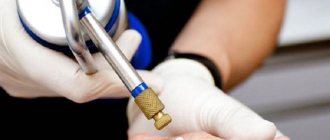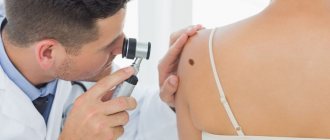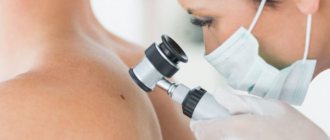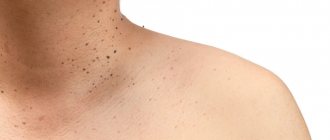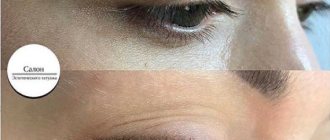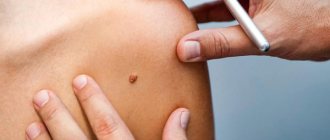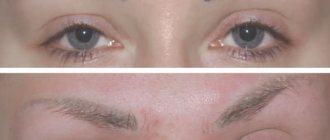New growths on the skin are not only a cosmetic defect, but also pose a certain threat to overall health. Therefore, the answer to the popular question “is it necessary to remove moles, warts, papillomas” is quite obvious. Timely diagnosis and treatment can prevent the progression of the disease and exclude the appearance of malignant neoplasms.
Certain treatment methods and massage procedures can be carried out to a limited extent or are contraindicated for many types of benign formations, for example, lipomas, hygromas, papillomas, etc. To remove them, non-surgical hardware methods are used, including radio wave, removal by coagulation, laser removal. We will tell you in more detail about which removal method is better, what tumors can be removed with their help.
What research is done before removing skin tumors?
The main optical device used by a dermatologist to examine moles and other skin growths before their removal is a dermatoscope. A dermatoscope consists of a magnifying lens and a light source to improve the visibility of subsurface structures of the skin.
The examination procedure using a dermatoscope is called dermatoscopy. This diagnostic method allows an experienced specialist to visually assess and diagnose the nature of a skin tumor under tens of times magnification.
Complications of benign neoplasms
Even if a benign neoplasm is not accompanied by unpleasant symptoms such as pain, growth or suppuration, it is necessary to be regularly examined by a dermatologist. The following types of formations are prone to malignancy:
- moles and nevi
- papillomas (in the form of a growth on the leg)
- condylomas (warts in the genital area)
- dermatofibroma (in rare cases)
Frequent damage and infection in the wound leads to inflammatory processes, which may involve surrounding tissues. Inflammation is accompanied by pain, if an area of exposed skin is affected, this is accompanied by severe psychological discomfort.
Timely removal of skin lesions prevents the risks of complications and reduces the volume of surgery.
What is the best method for removing skin tumors?
Our clinic's arsenal includes almost all methods for removing any benign skin tumors, except for surgical and chemical destruction: laser removal, radio wave removal - radiosurgery, diathermocoagulation - plasma coagulation and cryodestruction - removal with liquid nitrogen.
In each individual case, the question of choosing a removal method depends on the nature of the tumor, its size, location, and concomitant pathologies. Therefore, the concept of the best removal method simply does not exist.
Indications for histological examination
Histological examination differentiates a benign process from a malignant one. For histological analysis, fragments of a tumor or mole taken during removal are used. Histological analysis consists of examining thin sections of pathological tissue using an electron microscope. If histological results show signs of a malignant process, the skin in the area of the removed tumor is excised more widely.
All tumors removed surgically or excised by other methods can be subjected to histological examination. With laser destruction, tumor tissue is destroyed, and histological analysis becomes impossible.
How can a tumor be removed without leaving a trace on the skin?
All superficial neoplasms - papillomas, keratomas, etc., as well as small formations, are most often removed without scars or marks on the skin. After removal of large formations, traces of hypopigmentation or barely noticeable whitish scars may remain.
In any case, it is very important when removing! clearly assess the line separating the difference between the aesthetic result of the procedure and its effectiveness. This means that the wider and deeper the tumor is removed, the lower the likelihood of relapse. Conversely, minimal superficial removal is always an ideal cosmetic result, rapid epithelization, absence of a scar, but a high risk of developing recurrent neoplasm at this site. The experience of our doctors, mandatory diagnostics and the availability of a wide range of equipment allow our specialists to maintain a competent balance between removing the tumor in full and obtaining the best possible cosmetic result of the procedure.
Preparing for tooth extraction
For many people, tooth extraction is a very unpleasant and even frightening procedure. In fact, such fears are a consequence of those times when this manipulation was done without anesthesia using rough instruments. Today dentistry has stepped far forward, so removal takes place in much more comfortable conditions. You should not be afraid of the procedure, because the right psychological attitude is also one of the important conditions for the success of the operation.
To ensure that no incidents occur during tooth extraction, you must inform the surgeon about your state of health. If you have allergies, chronic or acute illnesses, be sure to tell your doctor. The same goes for the medications you take. Avoiding complications will also help avoiding alcohol and cigarettes the day before the procedure.
It is important to remember that you will not be able to eat or drink for some time after tooth extraction. Therefore, it is recommended to eat well before the procedure.
Anesthesia for tooth extraction
Tooth extraction is a rather painful procedure, so it is almost never performed without anesthesia. The exception is people with allergies to anesthetic drugs. Most often, when extracting teeth, local anesthesia is used using an injection. Usually we are talking about the so-called conduction anesthesia, which is injected directly into the nerve and has an increased concentration of the active substance. Naropin, ultracaine, ubistezin, etc. are used as the latter.
In addition to local anesthesia, general anesthesia may also be used during tooth extraction. Today, sedation is the most popular. This is a procedure in which the patient is given a strong sedative. He is in fact conscious, but does not feel pain and remains as if in a dream. Anesthesia is a more serious procedure that involves complete loss of consciousness, which in turn entails a longer recovery period.
General anesthesia for tooth extraction is used if the patient is intolerant to drugs for local anesthesia. In addition, it is used if a person has mental disorders, as well as if he experiences severe fear of the procedure. It is also justified if several teeth are to be removed at the same time. For example, sedation is often used when wisdom teeth are extracted. The procedure is done under the supervision of an anesthesiologist. Before the manipulation, the patient undergoes tests, performs a cardiogram and other procedures to diagnose the condition of the body.
What are the advantages of the radio wave method compared to other removal methods?
The radio wave method for removing skin tumors is the most non-traumatic procedure, which is based on the use of high-frequency waves (radio waves) on the Surgitron apparatus, USA. This method is used even if it is necessary to remove an element located in a hard-to-reach place (oral mucosa, eyelids).
The advantages of the radio wave method include:
- complete absence of pain during the procedure;
- no bleeding after removal;
- no trace remains at the site of removal;
- no risk of secondary infection;
- healthy areas remain untouched;
- fast healing process;
- The method is universal - you can remove warts, papillomas and moles.
One of the important differences between radiosurgery and laser and other destructive techniques is the possibility of performing a histological examination of removed tissue when using the radio wave method of removal.
Cold and chemical removal of warts, moles, condylomas: there are more disadvantages than advantages
Cryodestruction
- exposure to the formation of a refrigerant (usually liquid nitrogen), freezing at a temperature of - 190 degrees, sufficient to destroy the tissues of the formation. Unlike a scalpel and current, cryodestruction does not leave scarring, so it can be used on any area of the skin and mucous membranes, even on the cervix. Liquid nitrogen is used in the treatment of erosion in nulliparous women.
The cold itself “freezes” the tissue, so anesthesia during cryodestruction is not necessary. This makes the technique convenient for treating patients who are allergic to anesthetics.
The main disadvantage of the method is the impossibility of accurately adjusting the depth and area of penetration of the coolant into the tissue. With weak treatment, unremoved cells remain, leading to relapse, and too deep treatment leads to the destruction of melanin pigment and the appearance of hypopigmentation - white spots that are difficult to get rid of.
After unsuccessful cryodestruction, poorly healing blisters and ulcers appear on the skin, caused by frostbite of the tissue around the removed formation.
Cauterization with various chemical solutions works in approximately the same way - feresol, condiline, verrucacid and other drugs that act on the skin with acids, alkalis and aggressive organic components (phenol, tricresol).
The disadvantage of their use is low selectivity. Along with the altered tissues, healthy ones that are affected by the substance also suffer, and sometimes part of the formation remains, leading to a relapse. This situation is especially dangerous when removing moles. After a chemical burn, nevi that are not completely removed become inflamed and can develop into an aggressive cancerous tumor - melanoma. The chemical components included in the preparations are dangerous for people with a tendency to allergic reactions.
Currently, agents are used to remove tumors that have an antiviral effect. They are effective against papillomas and warts, but growths of non-viral origin, such as moles or hemangiomas, cannot be removed with their help.
What happens after removal?
During the first day after the procedure, a dark brown scab (crust) will form at the site of the removed tumor. Healing takes from 2-3 days to 2-3 weeks, it all depends on the size of the tumor bed. After final epithelization, the crust will be torn off on its own. Within 1-3 months, the area of skin at the site of removal has a bright pink color, then it will acquire a normal skin color. If you follow all the doctor’s recommendations and properly care for the skin at the site of removal, no marks or scars will form.
Reasons for appearance
The root cause of the appearance of any warts is only one: the presence of the human papillomavirus in the human blood. HPV is the most common group of viruses on the planet: according to various sources, various strains of papillomavirus are present in the blood of most of the world's population.
Different strains of papillomavirus can cause tumors. These can be either benign warts, condylomas or papillomas, or malignant formations.
That is why the appearance of any skin tumor, as well as a change in its appearance or size, is a good reason to consult a dermatologist. What if what seems like a harmless wart is a symptom of a much more serious disease?
Are there any special recommendations for skin care after the removal procedure?
We issue the following recommendations in the form of a reminder to our patients:
- During the first 24 hours, do not wet the removal site.
- Treat the wound with Fukortsin solution 2 times a day for 3-5 days or Baneocin powder.
- Men: do not shave in the area of removal for 3-4 days.
- Women: do not apply cream or decorative cosmetics to the removal area for 3-4 days.
- You cannot pick or remove the crust yourself!!! in order to reduce the likelihood of atrophic/keloid scars, hypo- and hyperpigmentation.
- In cases of removal of large tumors, after the crust is rejected, apply Levomekol ointment locally 1-2 times a day for a month.
- Before going outside, be sure to use sunscreen on the face and open areas of the body with an SPF of at least 50, especially on sunny days (to prevent pigmentation of the treated areas).
Contraindications to tooth extraction
Of course, if the situation is urgent and tooth extraction is inevitable, the doctor will perform the procedure immediately after the patient seeks help. But if the operation is planned, then in some cases it is recommended to refrain from it. Contraindications include the following conditions:
- acute viral disease, pneumonia;
- oncology;
- some blood diseases;
- recent myocardial infarction;
- tumors and other lesions in the oral cavity.
In addition, tooth extraction is a procedure undesirable for pregnant women. But if it cannot be avoided, then doctors recommend, if possible, to carry it out in the second semester.
Removal of papillomas prices
| Procedure/zone | Price, in rubles |
| Initial doctor's appointment before treatment | 900,00 |
| Removal of papilloma (up to 3 mm) on a leg on the body for 1 pc. (up to 10 pcs.) | 390,00 |
| Removal of papilloma (up to 3 mm) on a leg on the body for 1 pc. (from 11 to 20 pcs.) | 330,00 |
| Removal of papilloma (up to 3 mm) on a leg on the body for 1 pc. (from 21 to 30 pcs.) | 270,00 |
| Removal of papilloma (up to 3 mm) on a leg on the body for 1 pc. (more than 30 pcs.) | 210,00 |
| Removal of papilloma (up to 3 mm) on a pedicle on the face for 1 pc. | 850,00 |
| Removal of papilloma (up to 3 mm) of the ciliary edge, for 1 piece. | 3 000,00 |
| Removal of papilloma (up to 3 mm) of the eyelid, for 1 piece | 1 200,00 |
| Removal of papilloma (up to 3 mm) on the skin of the genital organs, for 1 piece | 1 200,00 |
| Application anesthesia, 5 grams | 800,00 |
| Histology | 2 990,00 |
| **Methodological recommendations No. 99/28 dated February 22, 1999 |
all prices in the section Laser cosmetology prices
- All Promotions
- Consultation
- 900 rub. 0 rub.1
- Laser removal of papillomas on the body
- 330 rub. 100 RUR/pcs 1 to 3mm diameter
- 1 If the procedure is carried out on the day of consultation, see the conditions
- Sign up
When should warts in the groin in men be removed?
Warts caused by the papilloma virus should be removed in all cases. The fact is that growths on the skin of a viral nature do not tend to disappear on their own. In addition, if nothing is done, such warts multiply uncontrollably and in a few days can spread throughout the perineum, groin areas and genitals. Skin formations in the groin of a different nature are treated differently. Manifestations of sexually transmitted diseases are eliminated with general medications, for example, tablets and injections. Benign soft fibroids can be left alone if they do not particularly interfere or cause pain. Cancers are treated according to all the principles of oncology.
Rice. 2. Multiple warts in the groin
Types and danger of cervical papillomas
You should decide how to remove papillomas on the neck only after making sure that the skin growth is actually a papilloma. For this purpose, it is best to contact a specialist who, based on the results of PCR diagnostics and a simple examination, will make a final diagnosis. In general, it is quite difficult to confuse a papilloma on the neck with any other neoplasm. Characteristic signs of the viral nature of a skin growth are painlessness and external signs.
Papillomas protrude above healthy tissues, attaching to them through a thin stalk or large base. The consistency of papilloma can be moderately dense or soft, and the color varies from light pink to dirty brown.
Neoplasms of this localization can be vulgar or flat in appearance, and can also be small papillomas on the neck that have a yellow tint. It is believed that representatives of the stronger sex are more prone to such localization of epidermal growths.
The transformation of skin papilloma into a malignant tumor is unlikely, which cannot be said about the possibility of injuring, tearing or rubbing delicate tissue. Such mechanical damage is fraught with the following consequences:
- Severe bleeding (proliferation of the capillary network is usually observed around the papilloma);
- Infection of the wound surface (skin damage is an open gate for infection and microbial contamination);
- Autoinaculation (contamination of infected blood on healthy areas of the epidermis can lead to repeated self-infection, which is manifested by multiple “warts”);
- Formation of scars (the neck is an open part of the body, the aesthetic appearance of which is important in shaping the overall image).
Who removes moles
Regardless of the location and size of the nevus, its removal is a relatively simple task for modern medicine. There are a number of effective hardware techniques that give specialists the opportunity to perform such operations under local anesthesia, without the risk of developing serious complications.
At the same time, it is very important to understand that removal of a mole should only be done by a dermatologist or oncologist who can professionally assess the nature of the nevus and exclude the possibility of cancer. You should not entrust this work to a cosmetologist, even if the removal is carried out for aesthetic reasons.
And even more so, you cannot use folk remedies - they can trigger the mechanism for the degeneration of cells into a cancerous tumor, and such cases are not uncommon.



